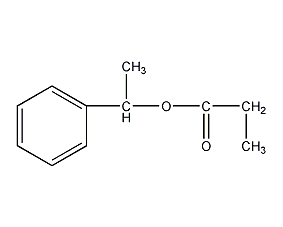
Structural formula
| Business number | 03C7 |
|---|---|
| Molecular formula | C11H14O2 |
| Molecular weight | 178.22 |
| label |
α-methylbenzylpropionate, phenethyl propionate, 1-phenylethyl propionate, Styralyl propionate, modifier, enhancer |
Numbering system
CAS number:120-45-6
MDL number:MFCD00009305
EINECS number:204-397-3
RTECS number:DP0620000
BRN number:None
PubChem ID:None
Physical property data
1. Character: liquid
2. Density (g/mL,20℃): 1.010-1.020
3. Relative vapor density (g/mL,Air=1): Undetermined
4. Melting point (ºC): -60
5. Boiling point (ºC,normal pressure):244
6. Boiling point (ºC,3mmHg): Undetermined
7. Refractive index:1.493-1.496
8. Flashpoint (ºC):93
9. Specific rotation (º): Undetermined
10. Autoignition point or ignition temperature (ºC): Undetermined
11. Vapor pressure (mmHg,25ºC): Undetermined
12. Saturated vapor pressure (kPa, ºC): Undetermined
13. Heat of combustion (KJ/mol): Undetermined
14. Critical temperature (ºC): Undetermined
15. Critical pressure (KPa): Undetermined
16. Oil and water (octanol/Log value of the partition coefficient for water: undetermined
17. Explosion upper limit (%,V/V): Undetermined
18. Lower explosion limit (%,V/V): Undetermined
19. Solubility: Undetermined
Toxicological data
1, exciting Safety: Rabbit percutaneous standard Drez test: 500mg/24H Mild stimulation.
2, acute Toxicity: Rat oral LD50: 5200mg/kg
Rabbit transdermal LD5O:>5g/kg
Ecological data
None
Molecular structure data
5. Molecular property data:
1. Molar refractive index: 51.47
2. Molar volume (m3/mol):176.0
3. isotonic specific volume (90.2K):426.6
4. Surface Tension (dyne/cm):34.5
5. Polarizability(10-24cm3):20.40
Compute chemical data
1. Reference value for hydrophobic parameter calculation (XlogP): 2.5
2. Number of hydrogen bond donors: 0
3. Number of hydrogen bond acceptors: 2
4. Number of rotatable chemical bonds: 4
5. Number of tautomers: none
6. Topological molecule polar surface area 26.3
7. Number of heavy atoms: 13
8. Surface charge: 0
9. Complexity: 160
10. Number of isotope atoms: 0
11. Determine the number of atomic stereocenters: 0
12. Uncertain number of atomic stereocenters: 1
13. Determine the number of chemical bond stereocenters: 0
14. Number of uncertain chemical bond stereocenters: 0
15. Number of covalent bond units: 1
Properties and stability
None
Storage method
None
Synthesis method
None
Purpose
It is the most useful variety of phenethyl alcohol derivatives and can be used in many good perfumes. It works well for rose and lily of the valley 2 flower scent formulas. It is also suitable for use in jasmine, ylang-ylang, magnolia, carnation, lavender and oriental and woody fragrances. It is a modifier and enhancer of floral fragrances. It can also be used in tobacco flavoring and food flavors such as honey, strawberry, raspberry, apricot, peach and other fruity flavors.
mily: Arial; mso-hansi-font-family: Arial; mso-bidi-font-family: Arial”>Molar volume (m3/mol):176.0
3. isotonic specific volume (90.2K):426.6
4. Surface Tension (dyne/cm):34.5
5. Polarizability(10-24cm3):20.40
Compute chemical data
1. Reference value for hydrophobic parameter calculation (XlogP): 2.5
2. Number of hydrogen bond donors: 0
3. Number of hydrogen bond acceptors: 2
4. Number of rotatable chemical bonds: 4
5. Number of tautomers: none
6. Topological molecule polar surface area 26.3
7. Number of heavy atoms: 13
8. Surface charge: 0
9. Complexity: 160
10. Number of isotope atoms: 0
11. Determine the number of atomic stereocenters: 0
12. Uncertain number of atomic stereocenters: 1
13. Determine the number of chemical bond stereocenters: 0
14. Number of uncertain chemical bond stereocenters: 0
15. Number of covalent bond units: 1
Properties and stability
None
Storage method
None
Synthesis method
None
Purpose
It is the most useful variety of phenethyl alcohol derivatives and can be used in many good perfumes. It works well for rose and lily of the valley 2 flower scent formulas. It is also suitable for use in jasmine, ylang-ylang, magnolia, carnation, lavender and oriental and woody fragrances. It is a modifier and enhancer of floral fragrances. It can also be used in tobacco flavoring and food flavors such as honey, strawberry, raspberry, apricot, peach and other fruity flavors.

 微信扫一扫打赏
微信扫一扫打赏

